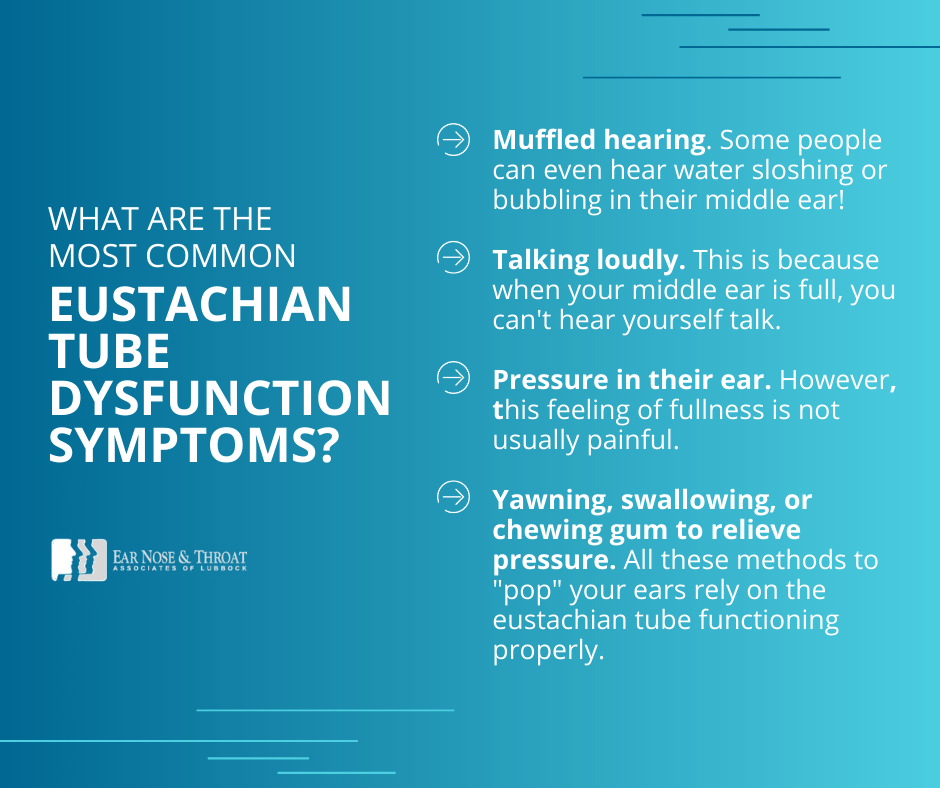What Are the Symptoms of Eustachian Tube Dysfunction?

Do you ever feel like you’re hearing the world from underwater? Or maybe your ears feel like you’ve been on an airplane and you just can’t get them to “pop.”
If so, you may be dealing with a case of eustachian tube dysfunction.
What Is the Eustachian Tube?
The eustachian tube is a tiny passage that connects the middle ear to the back of the nose.
Normally this tube stays open and helps to equalize the air pressure in the middle ear. It also allows any excess fluid from the middle ear to drain to the back of your nose and down your throat.
But when this tube becomes blocked due to inflammation or other causes, fluid builds up in the middle ear. Air can build up as well, since the eustachian tube is failing to maintain equal pressure.
This imbalance of fluid and air can lead to a group of symptoms that healthcare professionals call eustachian tube dysfunction.
What Are the Most Common Eustachian Tube Dysfunction Symptoms?
Patients with eustachian tube dysfunction often have muffled hearing, feeling like they’re hearing underwater or in a barrel. Some people can even hear water sloshing or bubbling in their middle ear!
Friends and loved ones might point out that you’re talking louder than normal. This is because when your middle ear is full, you can’t hear yourself talk as well. If you think you might be experiencing hearing loss, but it was very sudden in onset, it’s likely that the loss isn’t permanent.
Patients also often describe a feeling of fullness or pressure in their ear, though it’s not usually painful. One woman said she hadn’t felt pressure that intense since childbirth! (She even asked for an epidural.)
Trying to yawn, swallow, or chew gum to relieve the pressure will usually fail. All these methods to “pop” your ears rely on the eustachian tube functioning properly.

What Can I Do at Home To Manage My Eustachian Tube Dysfunction Symptoms?
Eustachian tube dysfunction symptoms can be very uncomfortable. If you begin to experience ear pain rather than just pressure, you should contact your ENT doctor right away. At that point you might be dealing with a middle ear infection.
But if you’re just experiencing the other symptoms mentioned above, you can try a variety of over-the-counter solutions before picking up the phone.
Antihistamines, decongestants and topical steroids can provide relief from eustachian tube dysfunction symptoms. These medications are helpful because many of the symptoms of eustachian tube dysfunction are due to swelling and congestion in the nasopharynx (the back of the nose).
A technique called autoinsufflation can also help in clearing the eustachian tube and restoring a bit of balance between the middle ear and the nasopharynx. To try this, pinch your nose and exhale gently through your mouth, but with your mouth closed. This technique can be a helpful way to release the pressure behind the eardrum.
We usually recommend first trying to decongest the nasopharynx area and seeing if that helps to improve your symptoms. If your symptoms persist after a month, or if they become more severe or painful, you’ll probably need medical help to deal with your eustachian tube dysfunction.
When Should I Call a Doctor?
If you’ve been dealing with pressure, fullness and that annoying underwater feeling for more than a month without any sign of relief, it’s time to call an ENT doctor.
Even if over-the-counter medications temporarily relieve the symptoms, if they return as soon as the medications wear off, you should still see a physician.
What Treatments Might an ENT Suggest?
It’s possible that a prescription-strength decongestant or topical steroid may solve your eustachian tube dysfunction. But some people (like children, people with allergies, or people who smoke) are more susceptible to eustachian tube dysfunction than others, and may have more persistent cases.
When the problem isn’t remedied by medications, even prescription strength, other options are available.
In cases like these, ear tube placement might help. Ear tubes open a tiny pathway between your middle ear and your outer ear. This equalizes pressure in your ear and allows any excess fluid to drain through your outer ear.
Ear tubes may not be right for everyone, or they may fall out over time. In these cases, eustachian tube balloon dilation can be a great option.
In eustachian tube balloon dilation, an ENT doctor inserts a small balloon into the eustachian tube and inflates it. This opens up the part of the tube that tends to collapse.
This short procedure involves very little risk or pain and has a high success rate. And because the balloon enters through the nose, there’s no cutting or scarring!
Dealing With Symptoms of Eustachian Tube Dysfunction?
If any of the above symptoms sound familiar and won’t respond to your go-to home remedies, call ENT Associates of Lubbock. Dr. Cuthbertson and Dr. Scolaro both have extensive experience treating eustachian tube dysfunction.
Make an appointment for a consultation to talk about your particular case and how we can best help you treat it!
Dr. Cuthbertson is a physician at Ear Nose & Throat Associates of Lubbock. He joined the team at ENT Lubbock from Houston, where he was chief resident of the prestigious Bobby R. Alford Department of Otolaryngology at Baylor College of Medicine. He is board certified in Otolaryngology and Head & Neck Surgery and has quickly built a reputation, not only as an extremely skilled surgeon, but as an approachable and compassionate clinician adept in the newest standards and technologies. Learn more about Dr. Cuthbertson.
Categories:








